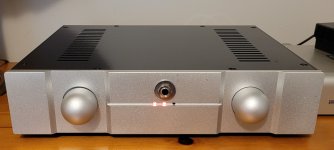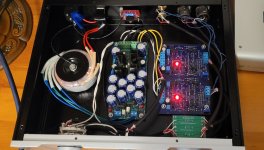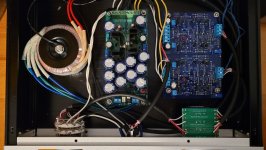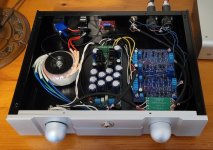Which ones did you choose?Goldpoint attenuators
Did they improves things significantly?
@mhenschel: after much discussion went with some older 44dB mono units that worked best for the dial setting with low-power amps (= knob pointers stay around 9-11 o'clock) and offer smaller increments that allow you to fine adjust the soundstage,
And, yes, they provided significant improvement that was immediately audible.
By contrast noted no improvement in moving from Uxcell to Grayhill source selectors.
And, yes, they provided significant improvement that was immediately audible.
By contrast noted no improvement in moving from Uxcell to Grayhill source selectors.
Just to confirm, I want to have balanced input to SE output. So just lift R17 ground and take -ve to it. Also want to lower gain as much as possible. Would changing R20 and R17 to 20k and R18 and R16 to 27k work to lower gain? What resistances would lower gain further, thanks.
Hello y´all,
For the most part Wayne's BA 2018 Linestage is ready. Just got to fix some cosmetic spots, but for now I'm listening with much pleasure to it's crystal clear sound and wide open stereo. I learned a lot, and it wasn't easy, and a maybe a too tough challenge for me, but I loved working on it. Especcially I'm happy with remote control volume (and mute). I might cover the case with tranparant sheet material, not sure yet. Have a nice weekend!
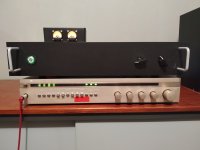
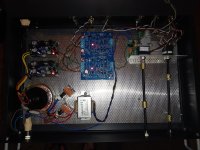
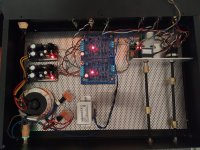
For the most part Wayne's BA 2018 Linestage is ready. Just got to fix some cosmetic spots, but for now I'm listening with much pleasure to it's crystal clear sound and wide open stereo. I learned a lot, and it wasn't easy, and a maybe a too tough challenge for me, but I loved working on it. Especcially I'm happy with remote control volume (and mute). I might cover the case with tranparant sheet material, not sure yet. Have a nice weekend!



Just ordered these 2 knobs. I need sophistication and some color .Hello y´all,
For the most part Wayne's BA 2018 Linestage is ready. Just got to fix some cosmetic spots, but for now I'm listening with much pleasure to it's crystal clear sound and wide open stereo. I learned a lot, and it wasn't easy, and a maybe a too tough challenge for me, but I loved working on it. Especcially I'm happy with remote control volume (and mute). I might cover the case with tranparant sheet material, not sure yet. Have a nice weekend!
View attachment 1335717View attachment 1335720View attachment 1335719
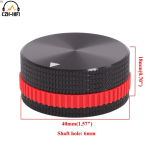
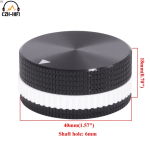
Bert, What remote volume control did you use?Remote control volume works fine 🙂 and I also managed to eliminate a slight hum with an improvised star point. All still in test setup, waiting for the case.
View attachment 1331832
I have raised R17 to 25k ohms to lower gain to around 2 as reported previously and it works. Can the gain be lowered even more than this.At the moment I am using a balanced input from the dac. The dac also has an SE output.
Lower as much as you want, but beware: it means increasing feedback and hence will affect sound in some way or another.
Using the SE output very likely lowers not so much the gain as the input level to the preamp.
After way too long, I just finished my BA2018-based headphone amp. I have only listened to it long enough to make sure it works, but will have a more serious listen tonight.
Case was bought a few years ago over at the Swap Meet. The PS is of course Mark's VRDN. Toroidal transformer is Antec. Shielded wiring is Gotham Audio GAC-4/1. Selector switch is a 6P3T that came from AliExpress. Pot is a 4-gang ALPS. Output is, at the moment, headphones only.
If I wanted to add pre-out, is it as simple as adding a switched jack, etc? Or is there something else that needs doing?
The rest of that system is a Schiit Bifrost served from a Raspberry Pi, running the squeezelite client.
I'm always amazed when these things actually work. I do not really understand how they work, but I can follow instructions well enough to build them! From my point of view, it's basically magic.
The center LED is a power indicator. The others indicate which of the two inputs (balanced or single-ended) is selected. I had originally used blue LEDs for the latter, but for some reason they would not light up. Only the red would. Not blue, not green, not white (all 3mm). I'm curious why that is. The power is taken from V+ (set at 19V), through a 15K resistor, and it wasn't a polarity issue.
Thanks to Wayne and Mark for their designs, and for everyone who is part of this community for encouragement and assistance!
Case was bought a few years ago over at the Swap Meet. The PS is of course Mark's VRDN. Toroidal transformer is Antec. Shielded wiring is Gotham Audio GAC-4/1. Selector switch is a 6P3T that came from AliExpress. Pot is a 4-gang ALPS. Output is, at the moment, headphones only.
If I wanted to add pre-out, is it as simple as adding a switched jack, etc? Or is there something else that needs doing?
The rest of that system is a Schiit Bifrost served from a Raspberry Pi, running the squeezelite client.
I'm always amazed when these things actually work. I do not really understand how they work, but I can follow instructions well enough to build them! From my point of view, it's basically magic.
The center LED is a power indicator. The others indicate which of the two inputs (balanced or single-ended) is selected. I had originally used blue LEDs for the latter, but for some reason they would not light up. Only the red would. Not blue, not green, not white (all 3mm). I'm curious why that is. The power is taken from V+ (set at 19V), through a 15K resistor, and it wasn't a polarity issue.
Thanks to Wayne and Mark for their designs, and for everyone who is part of this community for encouragement and assistance!
Attachments
Well....by not being aware there was an issue? The boards from the store are for balanced, aren't they? And the schematic at the store shows -IN but does not have the changes mentioned elsewhere. I was following that.
I have not tried the SE input, which just grounds -IN as usual.
I have not tried the SE input, which just grounds -IN as usual.
Hi Rikihek. Nice work...congratulations!
The switched jack is likely the easiest. Or just add an extra pair of RCA outputs on the back and promise yourself you won't use the headphone output and the RCA outputs at the same time...
Different LEDs have different power requirements and sometimes swapping one in for another might take some calculations. You need to deal with the power supply voltage, the LED voltage drop, the LED current rating, and the number of LEDs in the circuit. My point is if you know where you purchased the parts then head back there and check out the specs on the LEDs you purchased. Then search online for LED resistor calculator, of which you should be able to find quite a few. At that point you'll likely be able to find out why some of your parts work in your specific circuit while others do not. The other possibility is that the non-working LEDs simply got burned up from improper voltage. (My third thought: I'd otherwise guess that perhaps the 15K resistor dropped the voltage too much for those specific LEDs to work.)
If I wanted to add pre-out, is it as simple as adding a switched jack, etc? Or is there something else that needs doing?
The switched jack is likely the easiest. Or just add an extra pair of RCA outputs on the back and promise yourself you won't use the headphone output and the RCA outputs at the same time...
The center LED is a power indicator. The others indicate which of the two inputs (balanced or single-ended) is selected. I had originally used blue LEDs for the latter, but for some reason they would not light up. Only the red would. Not blue, not green, not white (all 3mm). I'm curious why that is. The power is taken from V+ (set at 19V), through a 15K resistor, and it wasn't a polarity issue.
Different LEDs have different power requirements and sometimes swapping one in for another might take some calculations. You need to deal with the power supply voltage, the LED voltage drop, the LED current rating, and the number of LEDs in the circuit. My point is if you know where you purchased the parts then head back there and check out the specs on the LEDs you purchased. Then search online for LED resistor calculator, of which you should be able to find quite a few. At that point you'll likely be able to find out why some of your parts work in your specific circuit while others do not. The other possibility is that the non-working LEDs simply got burned up from improper voltage. (My third thought: I'd otherwise guess that perhaps the 15K resistor dropped the voltage too much for those specific LEDs to work.)
I m wondering whether I made a bad wiring choice. The LEDs share a resistor. Ie, there is one resistor, then wires to the LEDs. Maybe sharing is not working.
Ben Mah, thanks for all help you have given me. Could you suggest a buffer design that I could try.
- Home
- Amplifiers
- Pass Labs
- Wayne's BA 2018 linestage
